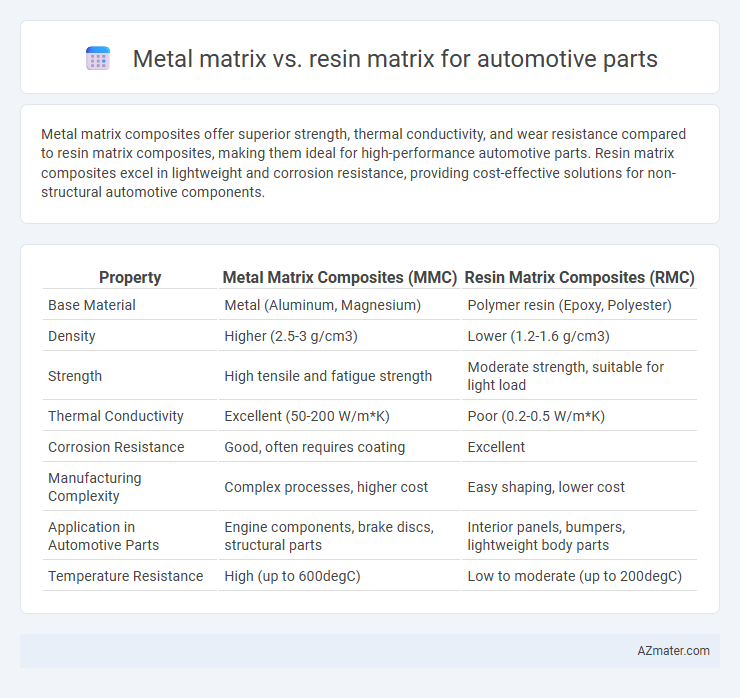Metal matrix composites offer superior strength, thermal conductivity, and wear resistance compared to resin matrix composites, making them ideal for high-performance automotive parts. Resin matrix composites excel in lightweight and corrosion resistance, providing cost-effective solutions for non-structural automotive components.
Table of Comparison
| Property | Metal Matrix Composites (MMC) | Resin Matrix Composites (RMC) |
|---|---|---|
| Base Material | Metal (Aluminum, Magnesium) | Polymer resin (Epoxy, Polyester) |
| Density | Higher (2.5-3 g/cm3) | Lower (1.2-1.6 g/cm3) |
| Strength | High tensile and fatigue strength | Moderate strength, suitable for light load |
| Thermal Conductivity | Excellent (50-200 W/m*K) | Poor (0.2-0.5 W/m*K) |
| Corrosion Resistance | Good, often requires coating | Excellent |
| Manufacturing Complexity | Complex processes, higher cost | Easy shaping, lower cost |
| Application in Automotive Parts | Engine components, brake discs, structural parts | Interior panels, bumpers, lightweight body parts |
| Temperature Resistance | High (up to 600degC) | Low to moderate (up to 200degC) |
Introduction to Matrix Materials in Automotive Parts
Metal matrix composites (MMCs) in automotive parts offer superior strength, thermal conductivity, and wear resistance compared to resin matrix composites, making them ideal for high-performance engine components and structural parts. Resin matrix composites provide lightweight solutions with excellent corrosion resistance and design flexibility, commonly used in interior panels and body applications to improve fuel efficiency. Understanding the distinct mechanical properties and thermal behaviors of metal versus resin matrices is crucial for optimizing material selection in automotive manufacturing.
Overview of Metal Matrix Composites (MMC)
Metal Matrix Composites (MMCs) consist of a metal alloy matrix reinforced with ceramic or metallic fibers, offering superior strength, stiffness, and thermal conductivity compared to resin matrix composites. MMCs provide enhanced wear resistance, improved high-temperature performance, and better load-bearing capacity, making them ideal for demanding automotive applications such as engine components and brake systems. These properties contribute to weight reduction, increased fuel efficiency, and extended part lifespan in vehicles.
Overview of Resin Matrix Composites (RMC)
Resin Matrix Composites (RMC) in automotive parts offer lightweight properties and high corrosion resistance, enhancing vehicle fuel efficiency and durability. These composites consist of a polymer resin matrix reinforced with fibers such as carbon or glass, providing excellent impact strength and design flexibility. RMCs are preferred for interior components and non-structural parts due to their cost-effectiveness and ease of manufacturing compared to metal matrix composites.
Comparative Mechanical Properties: Strength and Durability
Metal matrix composites (MMCs) exhibit superior strength and durability compared to resin matrix composites (RMCs) due to their high stiffness, thermal resistance, and load-bearing capacity under extreme conditions. MMCs offer enhanced wear resistance, fatigue strength, and impact toughness, making them ideal for automotive parts exposed to heavy mechanical stress and high temperatures. In contrast, RMCs provide lighter weight and corrosion resistance but generally possess lower tensile strength and durability, limiting their use in high-performance structural components.
Weight Reduction: Metal vs Resin Matrix Solutions
Metal matrix composites (MMCs) offer higher strength and thermal resistance but typically have greater density compared to resin matrix composites (RMCs), impacting weight reduction goals in automotive parts. Resin matrix composites, especially those reinforced with carbon fiber or glass fiber, provide significant weight savings due to their lower density, enhancing fuel efficiency and vehicle performance. Selecting between MMCs and RMCs depends on balancing the strength-to-weight ratio requirements and the specific application environments within the automotive industry.
Thermal Stability and Heat Resistance
Metal matrix composites exhibit superior thermal stability and heat resistance compared to resin matrix composites, making them ideal for high-temperature automotive parts such as engine components and brake systems. The metal matrix can withstand extreme temperatures without degrading, ensuring reliable performance and extended durability under thermal stress. Resin matrix composites, while lightweight, typically have lower heat resistance and can soften or deform when exposed to elevated temperatures in demanding automotive applications.
Corrosion and Chemical Resistance
Metal matrix composites exhibit superior corrosion resistance compared to resin matrix composites, especially in high-temperature and chemically aggressive automotive environments. Resin matrix composites can degrade more rapidly when exposed to oils, fuels, and solvents common in automotive applications, leading to potential structural failure. Advanced coatings and alloying in metal matrices further enhance chemical resistance, making them more reliable for long-term automotive part performance.
Manufacturing Processes and Cost Efficiency
Metal matrix composites in automotive parts offer superior mechanical properties and heat resistance, making them ideal for high-performance applications, but they require complex manufacturing processes such as powder metallurgy and infiltration, which increase production costs. Resin matrix composites benefit from more straightforward manufacturing techniques like injection molding and compression molding, enabling mass production at lower costs and with faster cycle times. The choice between metal and resin matrices largely depends on balancing the required performance attributes against cost efficiency during manufacturing.
Application Suitability: Common Automotive Uses
Metal matrix composites are widely utilized in automotive applications requiring high strength, heat resistance, and wear durability, such as engine components, brake rotors, and suspension parts. Resin matrix composites excel in lightweight body panels, interior trims, and aerodynamic components where corrosion resistance and design flexibility are critical. Selecting between metal and resin matrices depends on balancing mechanical performance with weight reduction goals and environmental exposure in automotive design.
Future Trends and Innovations in Composite Matrices
Metal matrix composites (MMCs) in automotive parts are advancing with innovations such as nano-reinforcements and additive manufacturing techniques, enhancing strength-to-weight ratios and thermal conductivity. Resin matrix composites (RMCs) benefit from bio-based resins and improved fiber-matrix adhesion, driving sustainability and durability in lightweight vehicle components. Future trends emphasize hybrid composite systems combining metal and resin matrices to optimize performance, manufacturing efficiency, and environmental impact for next-generation automotive applications.

Infographic: Metal matrix vs Resin matrix for Automotive part
 azmater.com
azmater.com